Feedback the Science and Art of Receiving Feedback Well Audible Book Free
Editor'southward Note: This article is function of "x Ways To Be A Meliorate Employee In 2015." Read the full list here.
No matter what we do or how well we do it, some criticism is eventually going to come our mode.
And those moments are often some of the toughest we all face in work and life. Hearing potentially negative things about yourself is probably not your favorite action, and most of the states would rather avoid the awkwardness that comes with telling someone else how they could meliorate.
But what practise we lose out on when we avoid these tough conversations? One of the fundamental skills of life is being able to give and receive advice, feedback and fifty-fifty criticism.
If given and received in the right spirit, could sharing feedback–fifty-fifty critical feedback–become a dissimilar, improve experience than the painful one we're accustomed to? Could feedback go a valued opportunity and fifty-fifty a bonding, positive feel?
In this mail, we'll explore how to requite and receive feedback at work in the best ways possible, forth with some of the psychology backside handling critical feedback (in both directions). I'll also share with you some of the methods in which we offer and receive feedback at Buffer to try and make the experience less scary and more loving.
What happens in our brains when we receive criticism
It's hard for us to feel like we're wrong, and it's even harder for us to hear that from others. As it turns out, there'south a psychological ground for both of these elements.
Our brains view criticism as a threat to our survival
Because our brains are protective of us, neuroscientists say they get out of their manner to make sure we ever feel similar we're in the correct–even when nosotros're not.
And when we receive criticism, our brain tries to protect us from the threat it perceives to our place in the social order of things.
"Threats to our continuing in the eyes of others are remarkably potent biologically, almost as those to our very survival," says psychologist Daniel Goleman.
So when nosotros look at Maslow'south famous bureaucracy of needs, nosotros might suppose that criticism is pretty high up on the pyramid–perhaps in the self-esteem or self-actualization quadrants. But considering our brains see criticism as such a primal threat, it's actually much lower on the pyramid, in the belonging or safety spectrums.
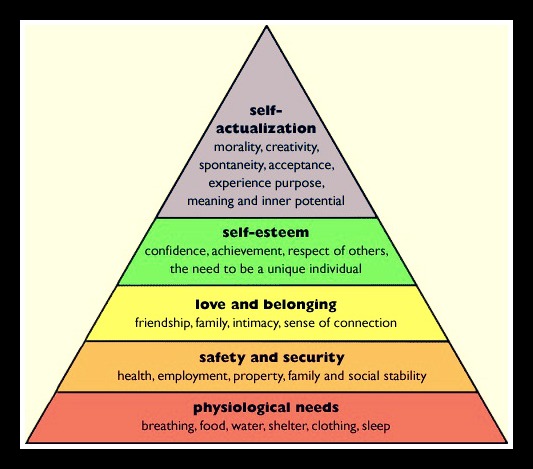
Criticism tin can feel like an bodily threat to our survival—no wonder it'south and so tough for us to hear and offer.
We recollect criticism strongly but inaccurately
Another unique thing about criticism is that we oftentimes don't remember it quite conspicuously.
Charles Jacobs, author of Management Rewired: Why Feedback Doesn't Work, says that when nosotros hear information that conflicts with our self-image, our instinct is to first change the information, rather than ourselves.
Kathryn Schulz, the author of Beingness Incorrect, explains that that's because "we don't experience, call back, runway, or retain mistakes as a feature of our inner mural," so wrongness "always seems to come at us from left field."
But although criticism is more likely to exist recollect incorrectly, we don't often forget it.
Clifford Nass, a professor of communication at Stanford University, says "almost everyone remembers negative things more strongly and in more than item."
It's called a negativity bias. Our brains have evolved separate, more than sensitive encephalon circuits to handle negative data and events, and they process the bad stuff more thoroughly than positive things. That means receiving criticism will ever have a greater bear on than receiving praise.
How to offer criticism the best way possible
And then at present that nosotros know what a delicate enterprise criticism can be, how tin we go about offering it upwards in the right spirit to get the all-time results? Here are some tips and strategies.
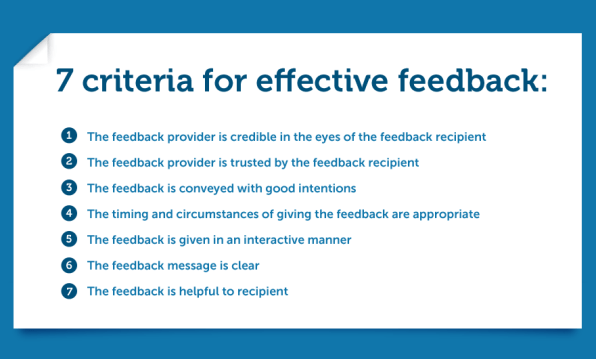
Reverberate on your purpose
The most important step is to make sure that your potential feedback is coming from the right place. Here's a list of some of the master motivating factors backside offering up feedback.
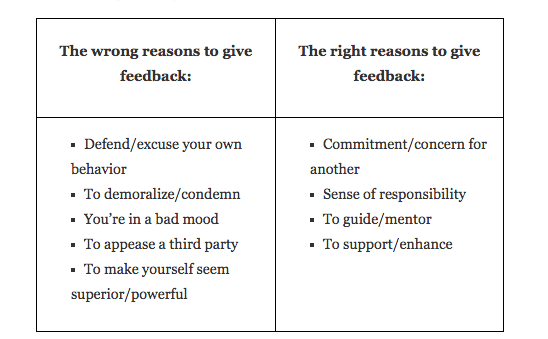
"When nosotros take difficult feedback to give, we enter the discussion uneasily, and this pushes us to the side of fearfulness and judgment, where we believe nosotros know what is wrong with the other person and how we can fix him," writes Frederic Laloux in his book Reinventing Organizations. "If nosotros are mindful, nosotros tin come to such discussions from a place of care. When we do, we can enter into beautiful moments of inquiry, where we have no like shooting fish in a barrel answers only can help the colleague assess himself more truthfully."
Focus on the beliefs, non the person
Subsequently entering the conversation with the best intentions, a side by side guideline is to separate beliefs or actions from the person you're speaking to.
Focusing the criticism on only the situation yous want to address–on what someone does or says, rather than the individual themselves–separates the problematic situation from the person's identity, allowing them to focus on what yous're saying without feeling personally confronted.
Lead with questions
Starting off your feedback with a few questions can help the other person feel like an equal office in the conversation as you lot talk over the challenge together.
Neal Ashkanasy, a professor of management at the University of Queensland in Australia, shared with Psychology Today the story of overcoming a tough feedback claiming–firing an assistant–with questions:
Ashkanasy began by asking her how she idea she was doing. That lead-in gives the recipient "joint ownership" of the conversation, he says. Ashkanasy too pointed to other jobs that would better match the skills of his shortlyhoped-for-ex employee. That hope of belonging helped save her anxiety most beingness cast out of the group she already knew.
Inject positivity: The modified 'criticism sandwich'
"Sandwich every bit of criticism between two heavy layers of praise." – Mary Kay Ash
One well known strategy for feedback is the "criticism sandwich," popularized by the higher up quote from cosmetics maven Mary Kay Ash. In the sandwich, y'all begin with praise, address the problem, and follow up with more praise.
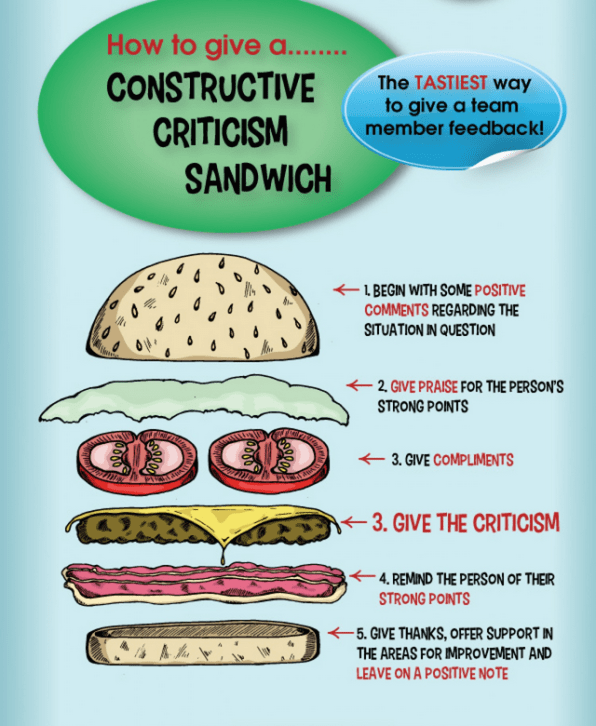
In fact, the more of the chat you lot can frame positively, the more likely your recipient is to exist in the right frame of heed to make the change yous're looking for.
The blog Zen Habits offers up some phrases to try to inject more positivity into your feedback, similar: "I'd dearest it if …" or "I think you'd do a groovy job with …" or "One affair that could make this even better is …"
Follow the Rosenberg method: Observations, feelings, needs, requests
In his exploration of the next stage of working together, Reinventing Organizations, Frederic Laloux explores some of the world's most highly evolved workplaces. One of the cultural elements common to all of them is the the ability to treat feedback as a gift rather than a curse.
As Laloux puts it, "feedback and respectful confrontation are gifts we share to aid one another grow."
Many of these organizations use the Rosenberg Nonviolent Communication method, pictured here, to deliver feedback.
This method provides a simple and anticipated framework that takes some of the volatility out of giving and receiving feedback.
The best way to set for and receive criticism
So now we know some strategies for offering feedback with an open up eye and heed. How about for receiving information technology?
Ask for feedback often
The best strategy for being caught off guard by negative feedback? Make sure you invite feedback often, particularly from those yous trust. You'll be better able to see any challenges ahead of time, and you'll gain feel in responding positively to feedback.
Yous tin begin by preparing some open up-ended questions for those who know you well and tin can speak with confidence about your work. Here are some great instance questions:
- If y'all had to make two suggestions for improving my work, what would they be?
- How could I handle my projects more than effectively?
- What could I practice to brand your job easier?
- How could I do a better job of following through on commitments?
- If you lot were in my position, what would you do to show people more appreciation?
- When do I demand to involve other people in my decisions?
- How could I do a better chore of prioritizing my activities?
Inquire for time to reflect on what you've heard, one element at a time
When receiving feedback, information technology might be tempting to go defensive or "explain away" the criticism. Instead, allow the other person stop completely and effort to mind securely. Then ask questions and reflect thoughtfully on what y'all've heard.
Stanford Professor Nass says that near people tin can have in only ane critical comment at a time.
"I take stopped people and told them, 'Permit me think most this.' I'm willing to hear more criticism but not all at ane time."
Then if you demand some time to reverberate on multiple points of feedback, don't be afraid to say then.
Cultivate a growth mindset
While some of united states have a hard time hearing negative feedback, at that place are those who thrive on it. This grouping has what'south known equally a growth mindset. They focus on their ability to modify and grow–equally opposed to those with a fixed mindset–and are able to see feedback as an opportunity for improvement.
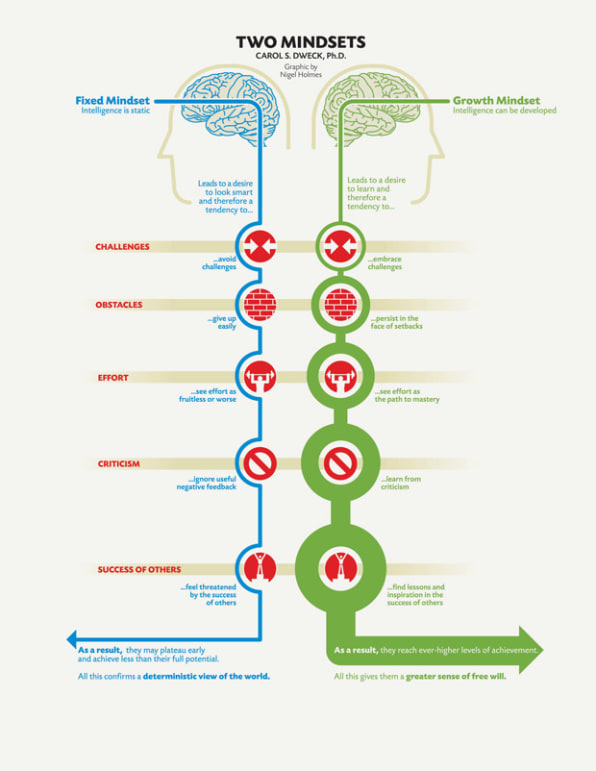
You can learn more about how to develop a growth mindset here.
Take credit for your mistakes and grow
It'due south easy to take credit for our successes, but failure is something we don't like to admit to. For instance, we're more likely to blame failure on external factors than our own shortcomings.
Simply lately, the idea of embracing failure has emerged, and information technology's a not bad mindset for making the most of feedback.
"Continual experimentation is the new normal," says business psychologist Karissa Thacker. "With chance comes failure. You cannot elevate the level of risk taking without helping people brand sense of failure, and to some extent, feel condom with failure."
Take a folio from the "embracing failure" move and treasure the opportunities you're given to ameliorate and grow.
How we give and receive feedback
As with many of the things we practise at Buffer, the manner we requite and receive feedback is a continuous work in progress as we experiment, learn and grow.
Previously, the feedback procedure was more or less formalized in a process we call the mastermind. Each team member would run into with a team leader every 2 weeks in a format with the following structure:
- 10 minutes to share and celebrate your achievements
- 40 minutes to talk over your current top challenges
- 10 minutes for the team lead to share feedback
- 10 minutes to requite feedback to the team lead
This procedure had a few really expert things going for it: Feedback was a regular, scheduled part of our discussions, which removed a lot of the fearfulness that can surround it; and feedback e'er went both ways, which made information technology experience like a sharing process between two equals.
These days, masterminds happen weekly between peers and we've moved away from the formalized feedback section altogether every bit we strive for a more than holacratic, less peak-down fashion of working together.
Simply feedback is still an important office of the Buffer journey, and it is offered and received freely past any of us at any time information technology is applicative.
Since feedback often can be sensitive and personal, it tends to be one of the only elements we exempt from our policy of radical transparency. It well-nigh often takes the form of one-on-ane Hipchat messages, emails or Sqwiggle conversations.
Our values guide the feedback process
Buffer'southward 10 core values are our guide to offering and receiving feedback with joy instead of anxiety.
Looking at our value of positivity through a lens of feedback, I come across lots of great education on offering constructive criticism, including focusing on the state of affairs instead of the person and offering equally much appreciation as feedback.

Since we each take on this goal of positivity, it's very easy to assume the all-time of the person offering their feedback to you and that their intent is positive.
Additionally, our value of gratitude ways that nosotros each focus on being thankful for the feedback as an opportunity to improve in a particular area.
Finally, our value of cocky-improvement ways we have a framework for taking feedback and acting on it in a way that moves us forward.

Although feedback isn't generally made public to the whole team, it's not uncommon for squad members to share feedback they've received and the changes they're making as a outcome in pair calls or masterminds.
I'1000 sure our ideas will evolve fifty-fifty farther on this idea (in fact, during the time information technology took me to write this we opened up a whole new discussion on feedback and resolving issues). Maybe you can give the states a hand?
I'd love to hear your best tips for giving and receiving feedback in the all-time spirit, or to larn how you handle feedback at your workplace! Share your thoughts with me in the comments.
This article originally appeared in Buffer and is reprinted with permission.
Source: https://www.fastcompany.com/3039412/the-art-science-to-giving-and-receiving-criticism-at-work
Belum ada Komentar untuk "Feedback the Science and Art of Receiving Feedback Well Audible Book Free"
Posting Komentar